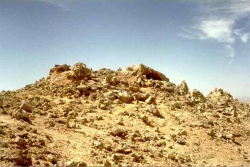äÇø
äÇø àÁãåÉí (Har Ë•domꞋ , See Har Ei•sauꞋ .
äÇø òÅùÒÈå (Har Ei•sauꞋ , Mount[ain of] Ei•sauꞋ , popularly Hellenized to "Esau"). Ei•sauꞋ was also known as Ë•domꞋ , who settled the region to the south of Yᵊhud•âhꞋ (Hellenized to "Judah," i.e. land of the Yᵊhud•imꞋ /Jews), in the region previously occupied by the Khor•imꞋ (hence, äÉø äÈäÈø, Hâr ha-Hâr, may originally have been çÉø äÈäÈø, Khor hâ-Hâr and identical with this mountain as well) fathering the people who became known as the "Edomites" (and, later, Idumeans).
In the second century B.C.E., John Hyrcanus forcibly converted the "Edomites," by then known as Idumeans, to Judaism. The inhabitants of Edom-Idumea "soon became an inseparable part of the Jewish nation" (Ency. Jud., 8.632). However, just as Herod was regarded as a false convert, other forced-convert Idumeans, especially after 70 C.E., reverted to their previous Arab heritage and culture.
The region of "Edom" included Beit LëkhꞋ ëm and Khë•vᵊr•onꞋ —today's Palistan (pseudo-Palestinians). More generally, however, Har Ei•sauꞋ symbolizes all non-Jews, especially those proximate to Tor•âhꞋ and Israel (the legitimate Jewish community).
äÉø äÈäÈø, Hâr ha-Hâr, see Har Ei•sauꞋ .
äÇø ëÌÇøëÌÉí (Har Kar•komꞋ ; Mount[ain of] Saffron), in the Israeli NëgꞋ ëv, modern name of äÇø ñÄéðÇé (Har Sin•aiꞋ , see below).
äÇø îÀâÄãÌåÉ or äÇø îÀâÄéãÌåÉ (Har Mᵊgid•oꞋ ; Mount[ain of] Mᵊgid•oꞋ ; meaning uncertain, perhaps "his choice" or "his announcing"), Hellenized to "Armageddon"; ancient Kᵊna•an•iꞋ and Yisrâ•eil•iꞋ city on the southern side of EiꞋ mëq (large, low-lying plain between mountainous areas) Yiz•rᵊ•ëlꞋ approx. 35 km (22 mi.) S.E. of Haifa.
Arab-occupied äÇø äÇîÌåÉøÄéÌÈä (Har Mor•i•yahꞋ (Mount[ain of the] Teaching of é--ä), usually referred to as äÇø äÇáÌÇéÄú (Har ha-BayꞋ it: (Mount[ain of the] House) in Hebrew, is paganized to "Temple Mount." Arabs are now trying to rewrite history (again), portraying this mount as a Moslem shrine lacking authentic Jewish history. Readers should always insert "Arab-occupied" before the phrase "Temple Mount" to help safeguard the historical correctness of Har ha-BayꞋ it.
äÇø ùÒÅòÄéø (Har Sei•irꞋ ; Hairy Mountain, or Mountain of the Hairy One), see Har Ei•sauꞋ
äÇø ñÄéðÇé (Har Sin•aiꞋ ; Mount[ain of] Chinese?), meaning uncertain. Scholars agree that Har Sin•aiꞋ is certainly NOT Mt. St. Catherines in the southern Sinai. I concur with archeologist Anati that Har Sin•aiꞋ is present-day Har Kar•komꞋ (above). Moreover, its meaning, the mount of Saffron, nicely corroborates the "Burning Bush."
îÄäÇø ñÄéðÇé (mi-Har Sin•aiꞋ ), from Har Sin•aiꞋ , or îÄñÄéðÇé (mi-Sin•aiꞋ ), from Sin•aiꞋ – pristine ancient Tor•âhꞋ as handed down to Mosh•ëhꞋ on Har Sin•aiꞋ .
äÇø öÄéÌåÉï (Har Tzi•yonꞋ ; Mount[ain of] Noteworthy). In Biblical times, Har Tzi•yonꞋ referred to Har Mor•i•yahꞋ (see above). Later, Har Tzi•yonꞋ came to refer to the next mountain across the valley (now across the KoꞋ tël Plaza) to the west, where most of the Ko•han•imꞋ lived. Today, Har Tzi•yonꞋ refers to the SW Gate area of Ir-Dâ•widꞋ .
äÇø äÇæÌÅéúÄéí (Har ha-Zeit•imꞋ (Mount of the Olives [press], Anglicized to "Mt. of Olives."
 |
 250x149.jpg) |
Google+ registered author-publisher

